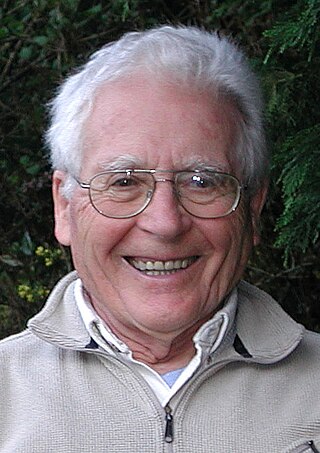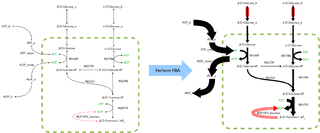Gaia philosophy is a broadly inclusive term for relating concepts about, humanity as an effect of the life of this planet.
In biology, homeostasis is the state of steady internal, physical, chemical, and social conditions maintained by living systems. This is the condition of optimal functioning for the organism and includes many variables, such as body temperature and fluid balance, being kept within certain pre-set limits. Other variables include the pH of extracellular fluid, the concentrations of sodium, potassium, and calcium ions, as well as the blood sugar level, and these need to be regulated despite changes in the environment, diet, or level of activity. Each of these variables is controlled by one or more regulators or homeostatic mechanisms, which together maintain life.

James Ephraim Lovelock was an English independent scientist, environmentalist and futurist. He is best known for proposing the Gaia hypothesis, which postulates that the Earth functions as a self-regulating system.

Stress, whether physiological, biological or psychological, is an organism's response to a stressor such as an environmental condition. Stress is the body's method of reacting to a condition such as a threat, challenge or physical and psychological barrier. There are two hormones that an individual produces during a stressful situation, well known as adrenaline and cortisol. There are two kinds of stress hormone levels. Resting (basal) cortisol levels are normal everyday quantities that are essential for standard functioning. Reactive cortisol levels are increases in cortisol in response to stressors. Stimuli that alter an organism's environment are responded to by multiple systems in the body. In humans and most mammals, the autonomic nervous system and hypothalamic-pituitary-adrenal (HPA) axis are the two major systems that respond to stress.

Daisyworld, a computer simulation, is a hypothetical world orbiting a star whose radiant energy is slowly increasing or decreasing. It is meant to mimic important elements of the Earth-Sun system. James Lovelock and Andrew Watson introduced it in a paper published in 1983 to illustrate the plausibility of the Gaia hypothesis. In the original 1983 version, Daisyworld is seeded with two varieties of daisy as its only life forms: black daisies and white daisies. White petaled daisies reflect light, while black petaled daisies absorb light. The simulation tracks the two daisy populations and the surface temperature of Daisyworld as the sun's rays grow more powerful. The surface temperature of Daisyworld remains almost constant over a broad range of solar output.

A superorganism or supraorganism is a group of synergetically interacting organisms of the same species. A community of synergetically interacting organisms of different species is called a holobiont.

The Gaia hypothesis, also known as the Gaia theory, Gaia paradigm, or the Gaia principle, proposes that living organisms interact with their inorganic surroundings on Earth to form a synergistic and self-regulating, complex system that helps to maintain and perpetuate the conditions for life on the planet.

The term autopoiesis refers to a system capable of producing and maintaining itself by creating its own parts. The term was introduced in the 1972 publication Autopoiesis and Cognition: The Realization of the Living by Chilean biologists Humberto Maturana and Francisco Varela to define the self-maintaining chemistry of living cells.
Creode or chreod is a neologistic portmanteau term coined by the English 20th century biologist C. H. Waddington to represent the developmental pathway followed by a cell as it grows to form part of a specialized organ. Combining the Greek roots for "necessary" and "path," the term was inspired by the property of regulation. When development is disturbed by external forces, the embryo attempts to regulate its growth and differentiation by returning to its normal developmental trajectory.
In systems theory, a system or a process is in a steady state if the variables which define the behavior of the system or the process are unchanging in time. In continuous time, this means that for those properties p of the system, the partial derivative with respect to time is zero and remains so:
Bioenergetics is a field in biochemistry and cell biology that concerns energy flow through living systems. This is an active area of biological research that includes the study of the transformation of energy in living organisms and the study of thousands of different cellular processes such as cellular respiration and the many other metabolic and enzymatic processes that lead to production and utilization of energy in forms such as adenosine triphosphate (ATP) molecules. That is, the goal of bioenergetics is to describe how living organisms acquire and transform energy in order to perform biological work. The study of metabolic pathways is thus essential to bioenergetics.

Tyler Volk is Professor Emeritus of Environmental Studies and Biology at New York University.

Flux balance analysis (FBA) is a mathematical method for simulating metabolism in genome-scale reconstructions of metabolic networks. In comparison to traditional methods of modeling, FBA is less intensive in terms of the input data required for constructing the model. Simulations performed using FBA are computationally inexpensive and can calculate steady-state metabolic fluxes for large models in a few seconds on modern personal computers. The related method of metabolic pathway analysis seeks to find and list all possible pathways between metabolites.

Ecological stoichiometry considers how the balance of energy and elements influences living systems. Similar to chemical stoichiometry, ecological stoichiometry is founded on constraints of mass balance as they apply to organisms and their interactions in ecosystems. Specifically, how does the balance of energy and elements affect and how is this balance affected by organisms and their interactions. Concepts of ecological stoichiometry have a long history in ecology with early references to the constraints of mass balance made by Liebig, Lotka, and Redfield. These earlier concepts have been extended to explicitly link the elemental physiology of organisms to their food web interactions and ecosystem function.
Allostasis (/ˌɑːloʊˈsteɪsɪs/) is a physiological mechanism of regulation in which the human body anticipates and adjusts its energy use according to environmental demands. First proposed by Peter Sterling and Joseph Eyer in 1988, the concept of allostasis shifts the focus away from the body maintaining a rigid internal set-point, as in homeostasis, to the brain's ability and role to interpret environmental stress and coordinate changes in the body using neurotransmitters, hormones, and other signaling mechanisms. Allostasis is believed to be not only involved in the body's stress response and adaptation to chronic stress; it may also have a role in the regulation of the immune system as well as in the development of chronic diseases such as hypertension and diabetes.
Research concerning the relationship between the thermodynamic quantity entropy and both the origin and evolution of life began around the turn of the 20th century. In 1910, American historian Henry Adams printed and distributed to university libraries and history professors the small volume A Letter to American Teachers of History proposing a theory of history based on the second law of thermodynamics and on the principle of entropy.
A glossary of terms relating to systems theory.
The balance of nature, also known as ecological balance, is a theory that proposes that ecological systems are usually in a stable equilibrium or homeostasis, which is to say that a small change will be corrected by some negative feedback that will bring the parameter back to its original "point of balance" with the rest of the system. The balance is sometimes depicted as easily disturbed and delicate, while other times it is inversely portrayed as powerful enough to correct any imbalances by itself. The concept has been described as "normative", as well as teleological, as it makes a claim about how nature should be: nature is balanced because "it is supposed to be balanced". The theory has been employed to describe how populations depend on each other, for example in predator-prey systems, or relationships between herbivores and their food source. It is also sometimes applied to the relationship between the Earth's ecosystem, the composition of the atmosphere, and weather.
The internal environment was a concept developed by Claude Bernard, a French physiologist in the 19th century, to describe the interstitial fluid and its physiological capacity to ensure protective stability for the tissues and organs of multicellular organisms.
In biology, energy homeostasis, or the homeostatic control of energy balance, is a biological process that involves the coordinated homeostatic regulation of food intake and energy expenditure. The human brain, particularly the hypothalamus, plays a central role in regulating energy homeostasis and generating the sense of hunger by integrating a number of biochemical signals that transmit information about energy balance. Fifty percent of the energy from glucose metabolism is immediately converted to heat.








